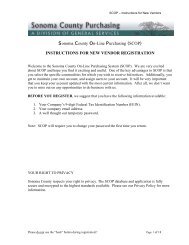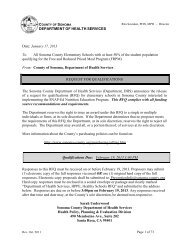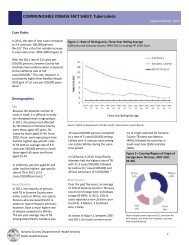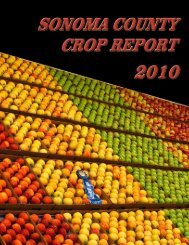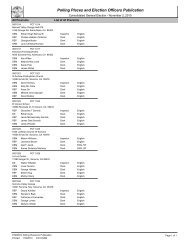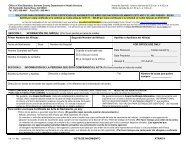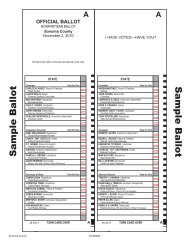Wine Industry Insider Report 2010 - Sonoma County
Wine Industry Insider Report 2010 - Sonoma County
Wine Industry Insider Report 2010 - Sonoma County
Create successful ePaper yourself
Turn your PDF publications into a flip-book with our unique Google optimized e-Paper software.
Moody’s Economy.com<br />
Industrial production is on the rise, and gross domestic<br />
product has increased for two consecutive<br />
quarters—most recently by 5.5% in the fourth quarter<br />
of 2009. U.S. GDP is forecast to grow at 2.8% in <strong>2010</strong><br />
before strengthening to faster rates of growth in 2011<br />
and 2012.<br />
The labor market has lagged behind improvements<br />
elsewhere in the economy. The U.S. unemployment<br />
rate will peak above 10% by the end of the year<br />
before declining in 2011. As a result of remaining<br />
labor market weakness, personal income is forecast to<br />
grow at a rate below 2% this year.<br />
The health of U.S. consumers will improve in<br />
the near term but is still some distance away from a<br />
full recovery. Retail sales, consumer confidence, stock<br />
markets and house prices have all risen above the<br />
depths they reached during the recession, but remain<br />
below pre-recession levels. Similarly, household net<br />
worth has partly recovered the losses of the past few<br />
years.<br />
The edging-down of the savings rate in the<br />
first two months of <strong>2010</strong> to 3.1%—below the 3.9%<br />
average for the second half of 2009—could signal<br />
that more affuent consumers are positioned to act<br />
upon pent-up demand for luxury goods such as<br />
high-priced wine. However, expectations of weak-atbest<br />
economic and labor improvements weigh on any<br />
outlook for an end to consumers’ flight to value in the<br />
near term.<br />
<strong>Industry</strong> drivers. The easing of drought conditions will<br />
set the stage for a second consecutive year of<br />
increased wine grape production in <strong>2010</strong> for <strong>Sonoma</strong><br />
<strong>County</strong> grape growers. This winter’s close-to-average<br />
rainfall in <strong>Sonoma</strong> <strong>County</strong> to date comes after last<br />
year’s late but plentiful rains, which resulted in an<br />
increase in the yield of wine grape crops throughout<br />
California’s various wine-growing regions last fall.<br />
The easing of drought conditions will help<br />
wine grape growers cope with increasing limitations<br />
on water use—at least in the near term. Proposed<br />
state limits on the diversion of water from the Russian<br />
River and its tributaries for frost protection are open<br />
to review and public comments. If <strong>Sonoma</strong> <strong>County</strong><br />
were to return to drought conditions in the future,<br />
growers fear that the limitations will make them<br />
unable to fight off late spring frosts, exposing their<br />
grape crops to large losses.<br />
Moody’s Economy.com • www.economy.com • help@economy.com • April <strong>2010</strong><br />
The buyers’ market for wine will increase interest<br />
in direct marketing and sales channels to consumers<br />
in the near term. In 2009, three states dropped<br />
prohibitions against direct shipments, leaving only 12<br />
states with complete bans. The expansion of direct<br />
wine shipments to additional states offers a lucrative<br />
distribution channel for specialty winemakers in<br />
<strong>Sonoma</strong> <strong>County</strong> that lack the distribution infrastructure<br />
of large wine companies.<br />
Despite the dwindling number of remaining<br />
direct shipment bans, complex licensing regimes<br />
remain in most states, making direct shipments a<br />
costly undertaking, especially for new entrants.<br />
Amazon.com backed away last year from its plan to<br />
offer online wine sales. As a result, Amazon’s Napabased<br />
fulfillment and logistics partner, New Vine<br />
Logistics, liquidated its operations this past fall.<br />
With barriers to entry limiting growth of direct<br />
shipments, wineries will seek other direct outlets to<br />
reach consumers. Many wineries in California’s winegrowing<br />
regions have taken advantage of falling<br />
construction and land prices to expand their tasting<br />
rooms. In addition, a new law in California last year<br />
expanded the offerings and locations of secondary<br />
satellite tasting rooms—many of which are located<br />
outside the county in large urban metro areas such as<br />
San Francisco. New bottling and packaging technologies<br />
are allowing more wineries to produce sample<br />
packages—a low-cost way to extend their direct marketing<br />
appeals to additional consumers.<br />
Pricing. The shift to value by consumers and wine<br />
retailers will put downward pressure on wholesale<br />
wine prices for <strong>Sonoma</strong> <strong>County</strong> wineries in <strong>2010</strong>.<br />
Demand remains weak in the wholesale market for<br />
wine priced above $35 a bottle—a <strong>Sonoma</strong> <strong>County</strong><br />
specialty—while demand for bottles priced $20 and<br />
below is rising, to the benefit of lower-cost wine<br />
growers outside the county. The increased yield of the<br />
2009 grape harvest will add further to the downward<br />
trend in prices.<br />
Retail pricing will continue to favor producers<br />
and distributors of low-priced wines in <strong>2010</strong>. Early<br />
sales data for <strong>2010</strong> from Nielsen Co. reflect that sales<br />
of wine priced between $9 and $20 are contributing<br />
significantly to retail wine sales volumes. However,<br />
some hope for at least stability in <strong>2010</strong> sales<br />
www.sonomaedb.org 3




